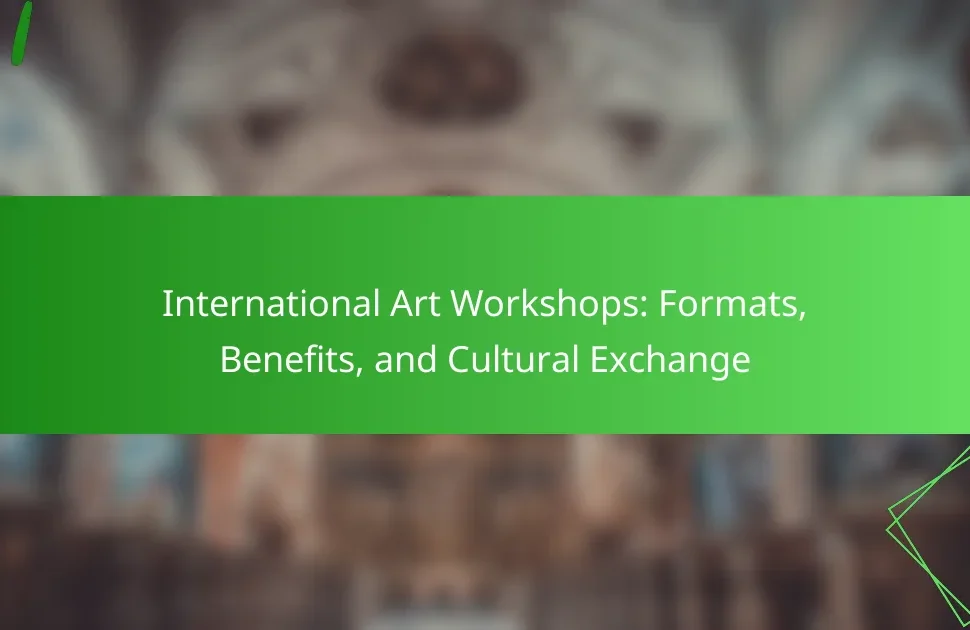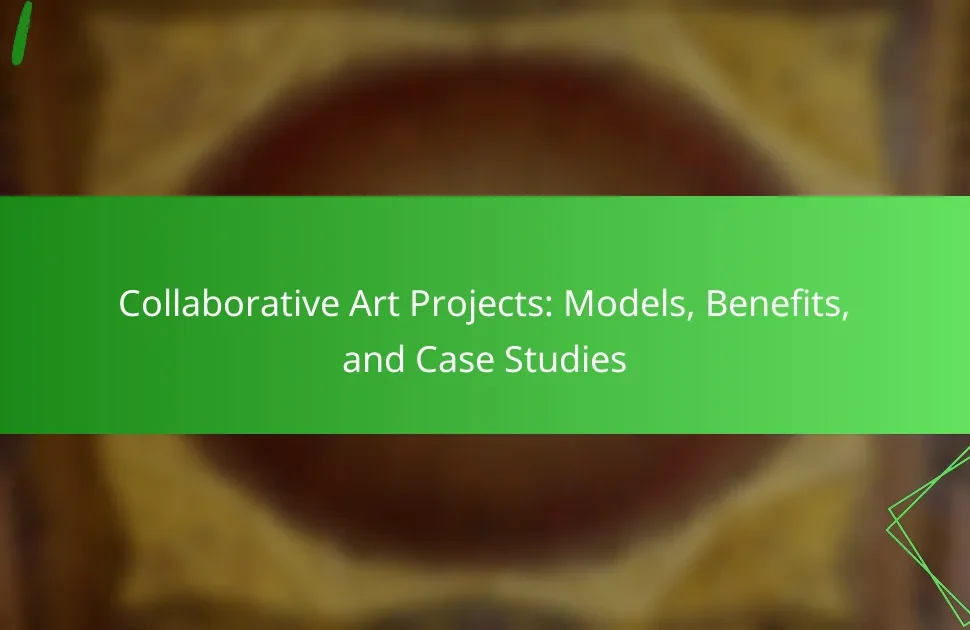Art festivals play a crucial role in cultural exchange and community engagement. This article explores the various types of art festivals, their cultural significance, and their global reach. It highlights prominent events like the Venice Biennale and Art Basel, and discusses the challenges and adaptations these festivals face in a changing world. Additionally, it offers tips for attendees to enhance their festival experience.
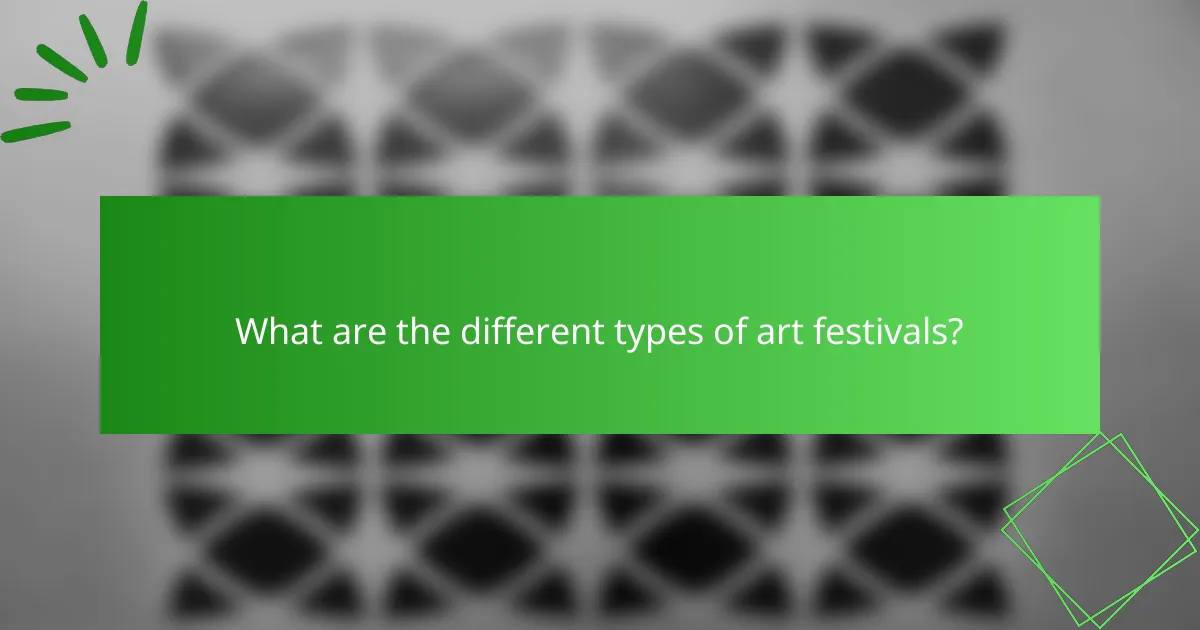
What are the different types of art festivals?
Art festivals can be categorized into various types, each highlighting different artistic expressions. These include visual arts festivals, performing arts festivals, film festivals, music festivals, and literary festivals. Each type showcases unique attributes, such as the specific art forms featured and the cultural significance they hold. Visual arts festivals often emphasize exhibitions and installations, while performing arts festivals focus on live performances. Film festivals celebrate cinematic works, music festivals spotlight various genres, and literary festivals promote authors and spoken word. The global reach of these festivals fosters cultural exchange and community engagement.
How do visual arts festivals differ from performing arts festivals?
Visual arts festivals focus on static forms like painting and sculpture, while performing arts festivals emphasize live performances such as theater and dance. Visual arts festivals often showcase exhibitions, installations, and galleries, allowing for prolonged engagement with artworks. In contrast, performing arts festivals feature scheduled shows, emphasizing the transient nature of live performances. Each type contributes uniquely to cultural expression and community engagement, highlighting different aspects of artistic creativity.
Which art festivals focus on specific cultural themes?
Numerous art festivals spotlight specific cultural themes. Examples include the Venice Biennale, which emphasizes contemporary art and national representation, and the Sundance Film Festival, focusing on independent cinema and storytelling from diverse cultures. The Edinburgh Festival Fringe showcases a variety of cultural performances, while the Indian Festival of Arts highlights traditional and contemporary Indian art forms. Each festival serves as a platform for cultural expression and dialogue.
What role do international art fairs play in the festival landscape?
International art fairs significantly influence the festival landscape by fostering global connections among artists, collectors, and audiences. These events showcase diverse artistic expressions, enhancing cultural exchange and promoting contemporary art. They also drive economic growth in host cities, attracting tourism and investment. Additionally, art fairs often serve as platforms for emerging artists, offering unique opportunities for exposure and recognition.
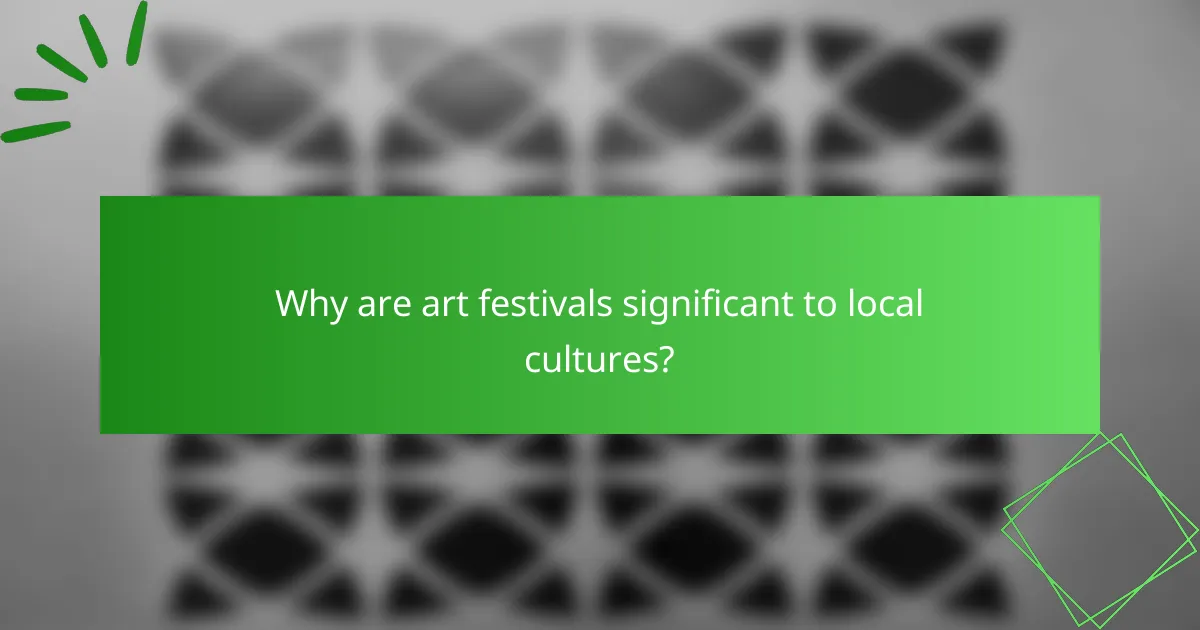
Why are art festivals significant to local cultures?
Art festivals are significant to local cultures because they foster community engagement, celebrate heritage, and promote local talent. These events serve as platforms for cultural exchange and artistic expression. They enhance tourism and economic development, attracting visitors and stimulating local businesses. Additionally, art festivals often highlight unique attributes of the local culture, such as traditional crafts and performances, making them vital for cultural preservation.
How do art festivals promote community engagement?
Art festivals promote community engagement by fostering creativity, collaboration, and cultural exchange. They provide a platform for local artists to showcase their work, which strengthens community identity. Festivals often include workshops and interactive activities, encouraging participation from diverse groups. As a result, they create a sense of belonging and pride among residents.
What impact do art festivals have on local economies?
Art festivals significantly boost local economies by attracting visitors and generating revenue. They create jobs, increase sales for local businesses, and enhance tourism. For instance, a study found that art festivals can contribute millions to local economies annually. Additionally, these events foster community engagement and cultural exchange, further enriching the economic landscape.
In what ways do art festivals preserve cultural heritage?
Art festivals preserve cultural heritage by showcasing traditional practices, promoting local artists, and fostering community engagement. They serve as platforms for storytelling, allowing diverse cultures to share their histories through art forms. Festivals often include workshops and demonstrations, reinforcing skills passed down through generations. Additionally, they attract tourism, generating economic support for local traditions and cultural preservation initiatives.

Which art festivals have gained global recognition?
Prominent art festivals that have gained global recognition include the Venice Biennale, Art Basel, and the Edinburgh Festival. These events showcase diverse artistic expressions and attract international audiences.
The Venice Biennale, established in 1895, is renowned for contemporary art and features national pavilions. Art Basel, held in Switzerland, Hong Kong, and Miami, emphasizes modern and contemporary art from leading galleries. The Edinburgh Festival, a celebration of performing arts, includes various art forms and draws millions each year.
Other notable festivals include the Documenta in Germany, which focuses on contemporary art every five years, and the Sundance Film Festival, highlighting independent film and media. These festivals contribute significantly to cultural exchange and artistic innovation worldwide.
What makes the Venice Biennale a standout event?
The Venice Biennale stands out due to its historical significance, international participation, and innovative exhibitions. Established in 1895, it has evolved into a premier platform for contemporary art. The event showcases diverse artistic expressions, attracting over 500,000 visitors from around the globe. Unique to the Biennale is its national pavilions, where countries present their artists, fostering cultural exchange. Additionally, its prestigious awards, such as the Golden Lion, highlight outstanding contributions to the art world. The Biennale’s influence extends beyond art, shaping cultural discourse and trends worldwide.
How does Art Basel influence the contemporary art market?
Art Basel significantly influences the contemporary art market by shaping trends, pricing, and artist visibility. The event attracts collectors, galleries, and curators, fostering a vibrant marketplace. Art Basel’s global reach enhances cultural exchange, making it a pivotal platform for emerging artists. Its unique attributes include exclusive exhibitions and high-profile sales, which set benchmarks for the art industry. As a result, participation in Art Basel often elevates an artist’s market value and recognition.
What are the unique features of the Edinburgh Festival Fringe?
The unique features of the Edinburgh Festival Fringe include its open-access nature, diverse performances, and international participation. It showcases thousands of acts across various genres, from theater to comedy. The festival emphasizes artistic freedom, allowing performers to present work without censorship. Additionally, it fosters a vibrant atmosphere, attracting millions of visitors each year, making it the world’s largest arts festival.
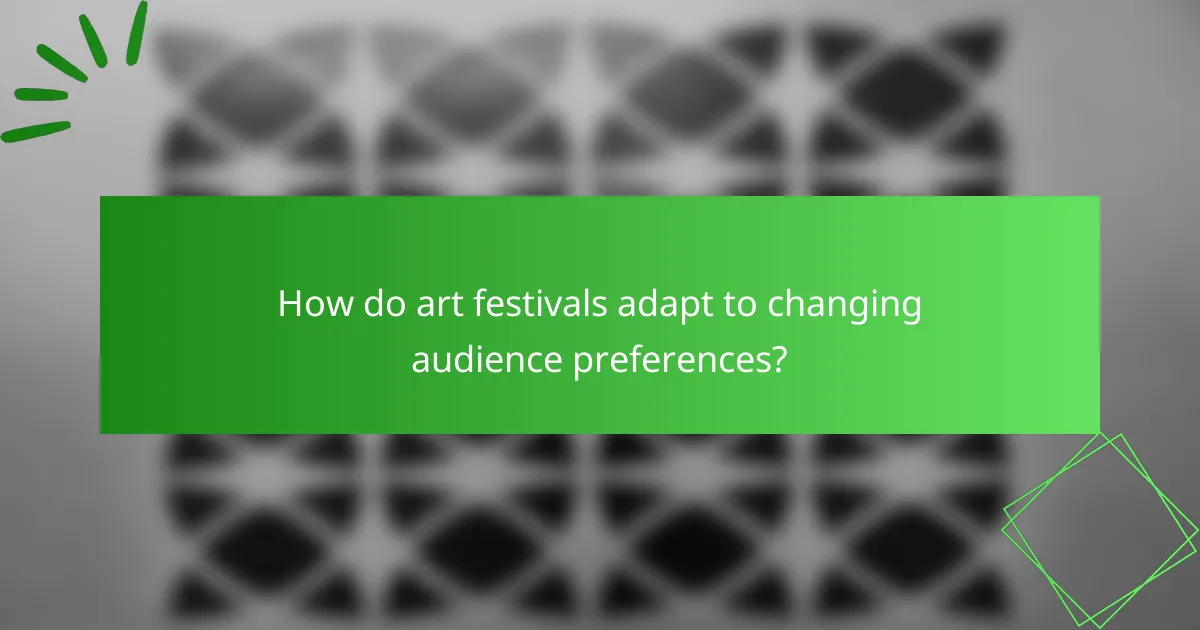
How do art festivals adapt to changing audience preferences?
Art festivals adapt to changing audience preferences by incorporating diverse programming and interactive experiences. These adaptations enhance engagement and cater to varied tastes.
For instance, festivals now feature multimedia installations, workshops, and performances that appeal to younger audiences. This shift reflects a growing demand for immersive experiences.
Additionally, festivals are increasingly utilizing digital platforms for promotion and ticket sales, making events more accessible. This approach aligns with the rise of online engagement.
Finally, collaborations with local artists and communities foster a sense of belonging, attracting attendees interested in cultural relevance and authenticity.
What innovative formats are emerging in art festival programming?
Art festivals are increasingly adopting innovative formats like immersive experiences, digital installations, and hybrid events. These formats engage audiences more deeply and expand the cultural significance of art. For example, immersive experiences allow visitors to interact with art in new ways, blurring the line between creator and audience. Digital installations leverage technology to create dynamic environments, enhancing accessibility and reach. Hybrid events combine in-person and virtual elements, catering to diverse audiences and fostering global participation. These trends reflect a shift towards inclusivity and interactivity in the art festival landscape.
How are digital technologies being integrated into art festivals?
Digital technologies are increasingly integrated into art festivals, enhancing experiences and accessibility. These technologies include virtual reality, augmented reality, and digital installations, which create immersive environments. For instance, festivals utilize apps for navigation and engagement, allowing attendees to interact with art in innovative ways. Additionally, live streaming and social media platforms expand reach, connecting global audiences to local events. This integration not only enriches the cultural significance of art festivals but also fosters community engagement and participation.
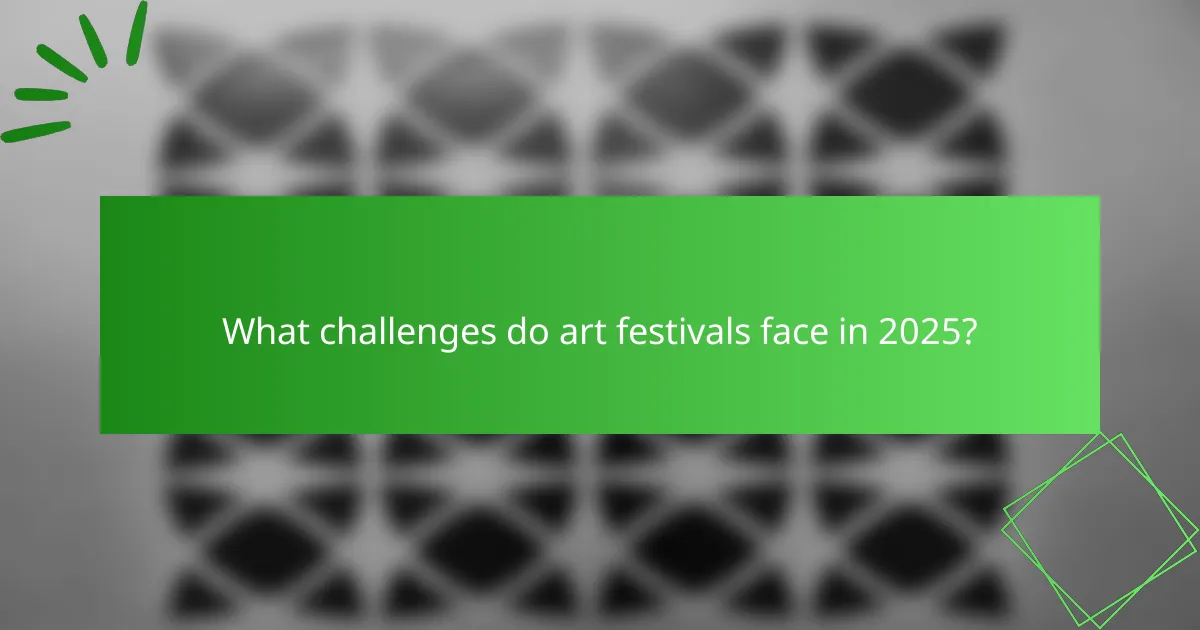
What challenges do art festivals face in 2025?
Art festivals in 2025 face challenges such as funding shortages, climate change impacts, and audience engagement. These factors threaten their sustainability and cultural relevance.
Funding shortages arise from economic fluctuations and competition for sponsorships. Climate change affects event planning due to unpredictable weather patterns. Additionally, engaging diverse audiences requires innovative programming and marketing strategies.
Art festivals must adapt to these challenges to maintain their cultural significance and global reach. Emphasizing sustainability and inclusivity can enhance their appeal and resilience.
How do economic downturns affect festival attendance?
Economic downturns typically lead to decreased festival attendance due to reduced disposable income and prioritization of essential spending. During financial crises, individuals often cut back on leisure activities, impacting ticket sales and vendor participation. Art festivals, which rely on discretionary spending, may see a significant decline in visitors. For instance, a study found that attendance at major art festivals dropped by approximately 30% during economic recessions. Additionally, sponsorships and funding for these events may diminish, further exacerbating the decline in attendance.
What strategies are festivals using to ensure sustainability?
Art festivals are adopting various strategies to ensure sustainability. These include implementing waste reduction programs, promoting local artists and vendors, using renewable energy sources, and encouraging eco-friendly transportation options. Many festivals are also focusing on community engagement to raise awareness about environmental issues. For example, some events feature workshops on sustainable practices and provide incentives for attendees who use public transport or carpool. These initiatives significantly reduce the environmental impact of festivals while enhancing their cultural significance.
In what ways are festivals addressing diversity and inclusion?
Art festivals increasingly promote diversity and inclusion through various initiatives. They showcase underrepresented artists, celebrate multicultural expressions, and create accessible spaces for all attendees. Many festivals implement outreach programs targeting marginalized communities, ensuring broader participation. Collaborative projects often highlight diverse narratives, fostering dialogue and understanding among different cultural groups. These efforts enhance the cultural significance of art festivals and expand their global reach.
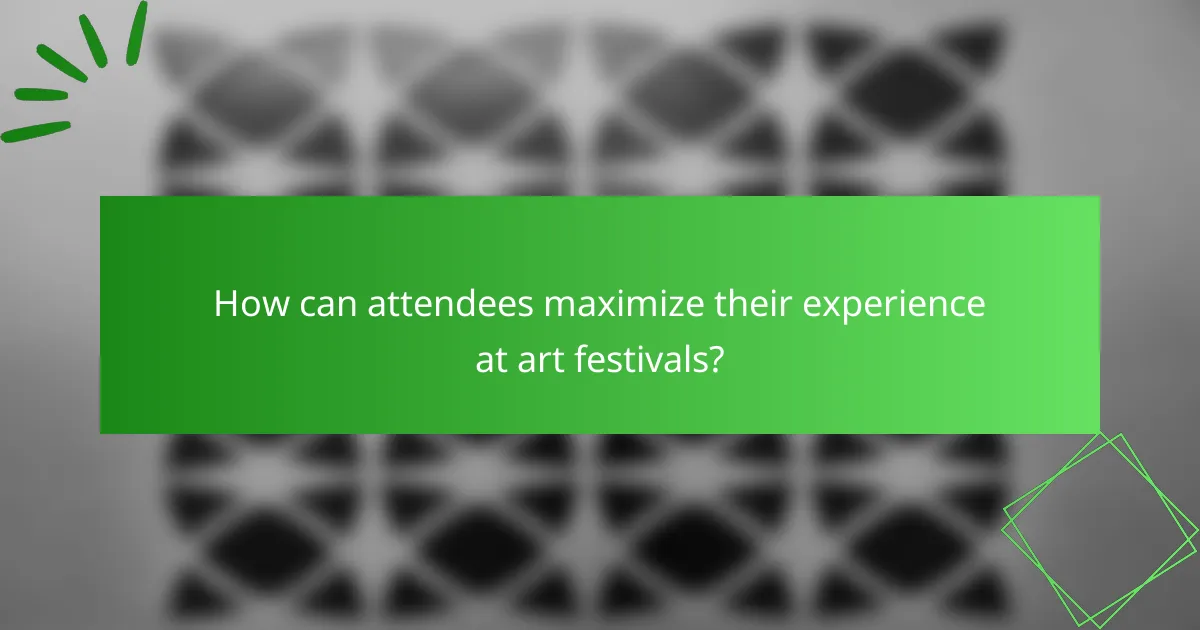
How can attendees maximize their experience at art festivals?
Attendees can maximize their experience at art festivals by planning ahead, engaging with artists, and exploring diverse exhibits. Research the festival schedule to prioritize must-see events and workshops. Interact with artists to gain insights into their work, enhancing appreciation. Embrace the variety of artistic expressions available, as this fosters a deeper understanding of cultural significance and global reach.
What are the best practices for planning your festival visit?
To plan your festival visit effectively, research the event schedule, ticket options, and transportation. Prioritize essential performances and experiences, and consider accommodations in advance. Engage with local culture through food and art to enhance your experience. Stay hydrated and wear comfortable clothing for prolonged enjoyment.
How can participants engage with artists and exhibitors effectively?
Participants can engage with artists and exhibitors effectively by actively visiting their booths, asking questions, and providing feedback. Building connections enhances the experience and fosters collaboration. Attending workshops and panel discussions offers deeper insight into artistic processes. Networking events allow for personal interactions, enriching the festival experience. Engaging through social media platforms can also extend conversations beyond the event.
What common mistakes should festival-goers avoid?
Festival-goers should avoid common mistakes to enhance their experience. Prioritize planning and preparation, such as researching the festival schedule and lineup. Arriving late can lead to missing key performances. Stay hydrated and nourished; neglecting this can diminish enjoyment. Wear appropriate clothing and footwear to ensure comfort throughout the event. Lastly, be mindful of personal belongings to prevent loss or theft.

